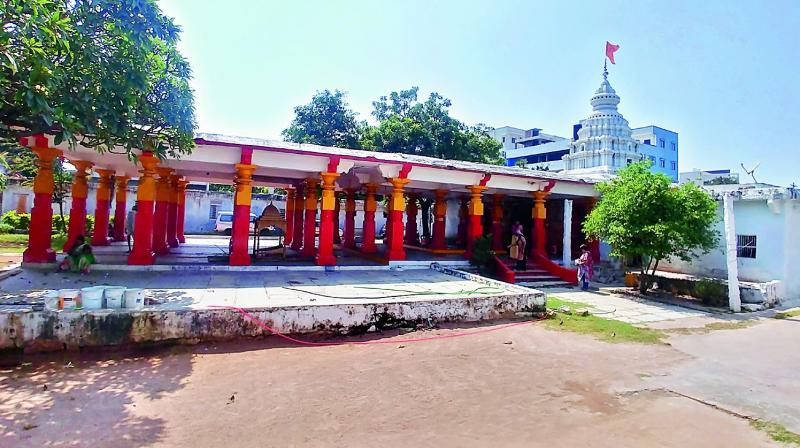Rambagh temple, a hidden gem in the Hyderabad
It is said, Sikander Jah Nizam III attended the idol installation ceremony.

Hyderabad: The Rambagh temple at Attapur, now within the confines of this thriving metropolis, was built as a token of devotion and a request for strength to face his sorrow by Raja Bhavani Prasad Bhatnagar.
The death of his only son had left him forsaken and then, at the behest of his family guru, this temple came into being in 1790.
Bhavani Prasad was given the moniker of Raja and was, as Kayasthas were in those days, a key official with the Nizam. The community had apparently come with the first Nizam from the North and became a part of the Nizam's darbar. Some of them rose to high positions.
The Nizam then gave Bhavani Prasad a mansab (rank or position) of Rs 1,500 with a jagir (a feudal land grant) from which he earned handsome rent. While a collector of revenue from others, he was also a soldier commanding a cavalry.
Soon it was time to look for a bride for his only son and even as celebrations were in order, the son died leaving the Raja in deep depression. Seeing his condition, the family priest, Gundachari, advised the nobleman to build a temple for Rama, since he was already a bhakt. The Raja built this beautiful temple on a large tract of land. However, all the temple still needed was an idol.
That is when Bhavani Prasad had a dream in which he was told that an idol was lying amidst salt in the Gadwal Samasthan. Salt is used as a preservative to keep idols in good condition. These idols had been made in Ananthasayanam in Kerala.
Gundachari was immediately despatched to fetch the idols which were under the care of Venkata Ramana Chari, a priest from Kerala who had been looking after them. It took Gundachari three to four months to travel and bring the idols.
After proper permissions were taken from Raja Som Bhupal of the Gadwal Samasthan, Venkata Ramana Chari who was the first generation priest for the Rambagh temple accompanied the idols of Rama, Lakshmana and Sita.
The idols were finally installed in 1802. It is said that Sikander Jah Nizam III attended the ceremony and participated in the inauguration, proving again the communal harmony that existed between the rulers (Muslims) and the subjects (Hindus) in Hyderabad. The Nizam also granted a jagir for the temple’s maintenance.
Mr Tirumala Deshabhakta Chari, who remembers the story to the last word, is the 10th generation priest of the temple. It was during his time that this temple was given an award by Intach (Indian National Trust for Art and Cultural Heritage) in 2015.
Though the priest does not remember how much land was dedicated to the temple, it stands on four acres, some of it still unoccupied.
The temple still has a peaceful aura in spite of the hectic activity around the place, even as the smell of cows and hay from the goshala fill the air. To protect the temple land, a wall surrounds it on three sides. The koneru tank, Ramagundam, is now covered with bushes. There were apparently two more, Sitagundam and Lakshmanagundam.
The temple has a few rooms which are occupied by people connected with the temple. All this is built in the vernacular style. Just outside the temple is a small mandapam used for kalyanam during Ramanavami when there is a chariot procession.
A huge crowd attends the temple then, but on other days there is a sparse crowd, primarily because people are not aware that there is such a gem right in their midst.
Though you enter the temple through the main road, a remnant of the limestone arch is still there, beautifully carved and pillared, cheek by jowl with small flats and their drying clothes.
The main darwaza or gate of the temple is huge and difficult to move and stone pillars protect this part of the building. Then there is an empty space, leading to the temple, which looks more like a well kept park, with mowed lawns and trimmed bushes. Three or four huge trees lend it a peaceful charm.
A set of colourful pillars add to the attraction, even as Ranaganathaswamy in his famous ‘shayanam’ position adorns the entrance. This must have come from the first priest for, after all, he was from Ananthashayanam in Kerala.
Inside, there is a huge bell of yesteryears, painted in a cheery yellow, but the gong is missing. The utsava murthis are as usually made of panchaloha, while the bigger idols of the triumvirate are in black granite stone. The idol of Lord Rama wears the Prabhawali of the Dasavatar.
The gopuram is made of limestone retains its originality and there is a Rajasthani touch to it with mini jharokhas around, but it has not been cleaned in a long time.
With the emoluments for the priest being at '1,000 and '500 towards puja, it is surprising that the temple is still open. With the endowments department taking over, one wonders what will happen in the future to this historical and charming temple.
While the endowments department is not keen on developing the temple, it is also rumoured that they are not keen on returning the jewellery belonging to the Lord, which had been taken away by the department once it took over.
While the family did look after the temple for some time, with the death of Vinay Mohanlal Bhatnagar, the legatee of Bhavani Prasad, it has been handed over to the endowments department. Deshabhakta Chari too will be the last in his generation to perform puja in this temple, because his two sons have not shown any interest in performing pujas in this old and quaint temple.

